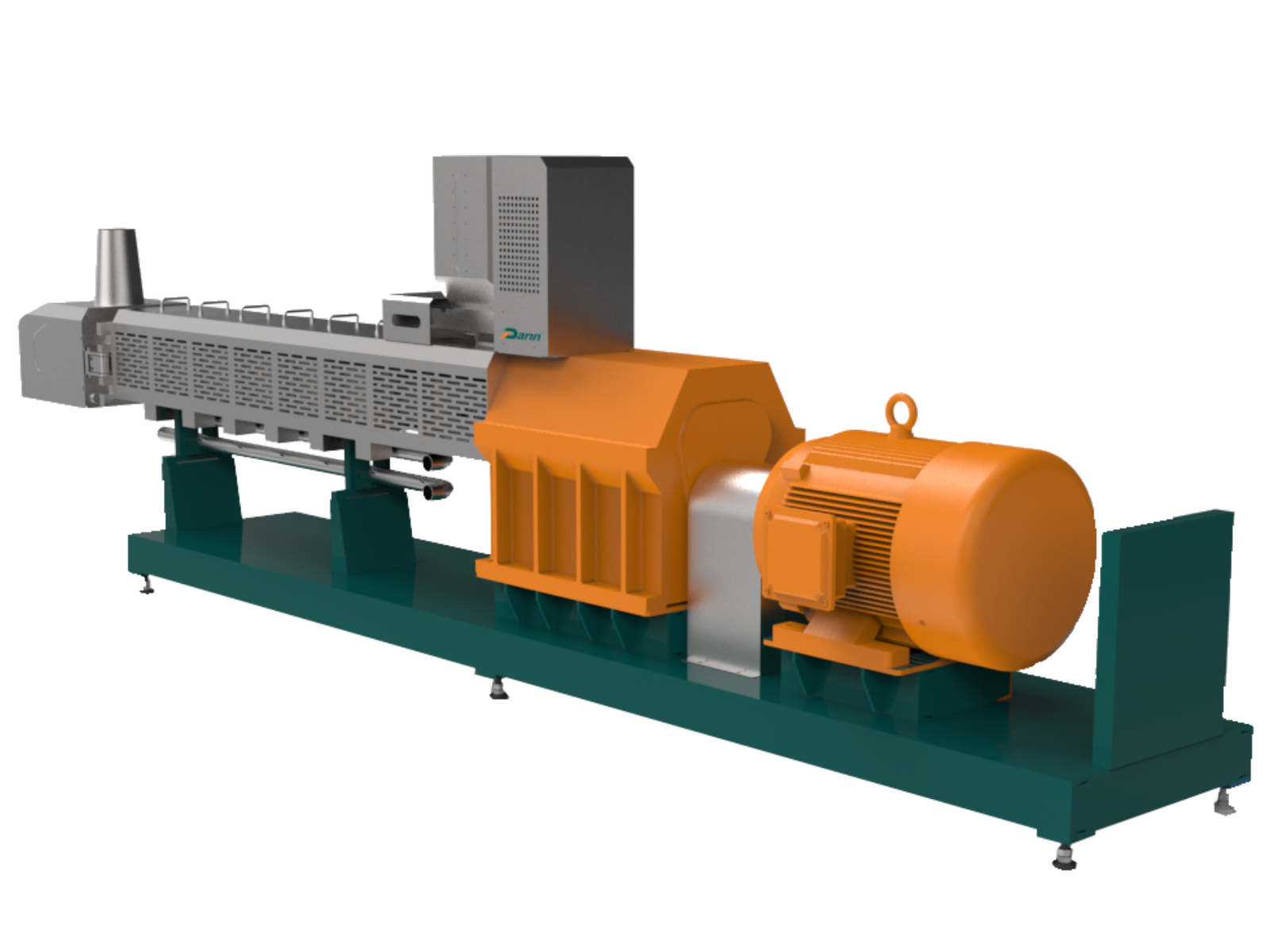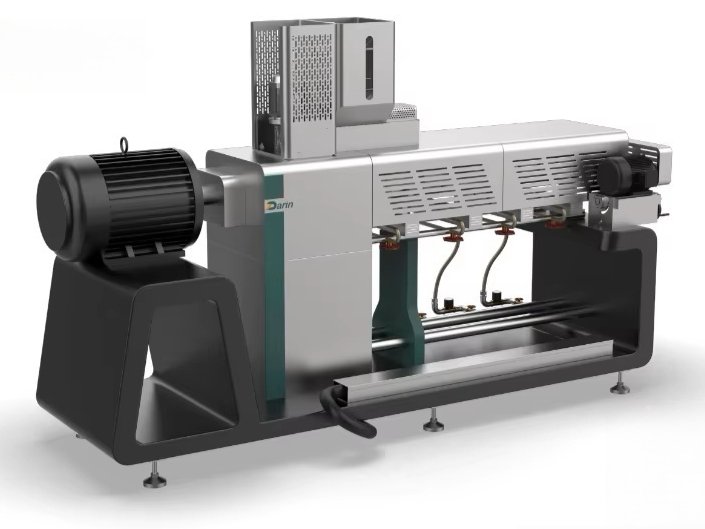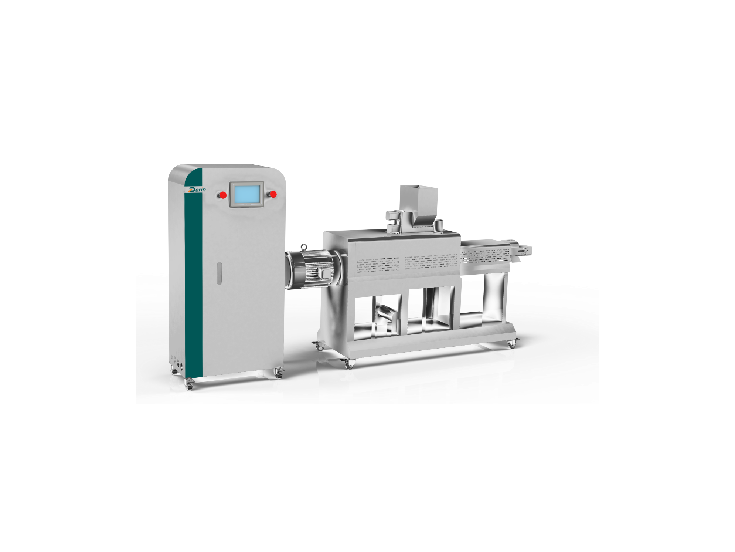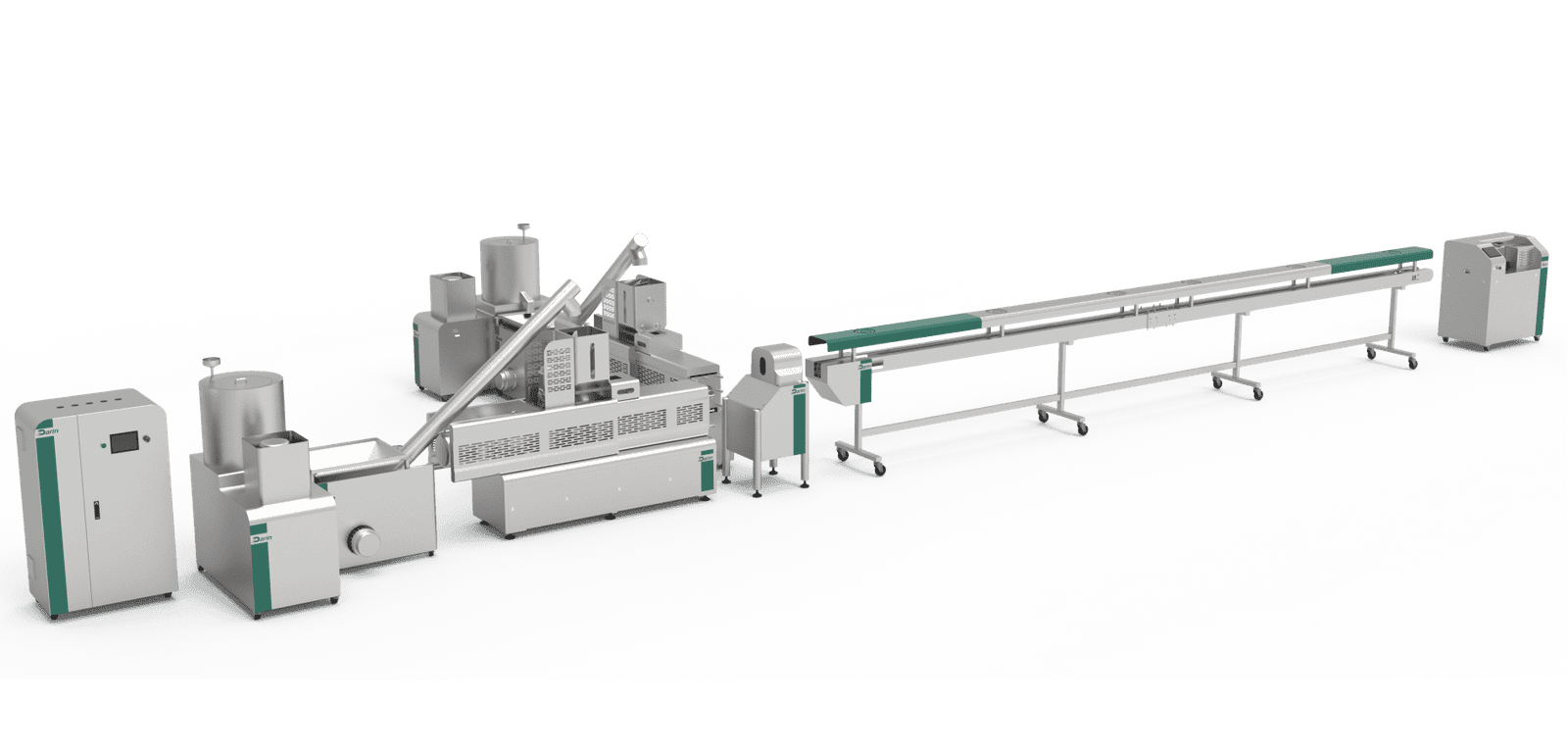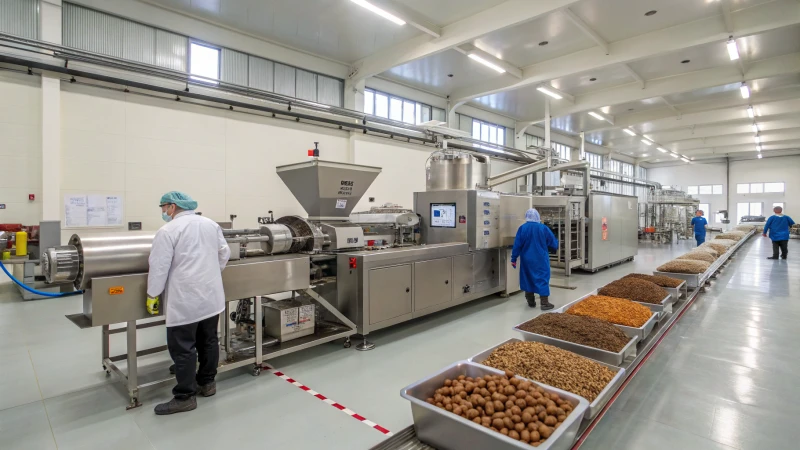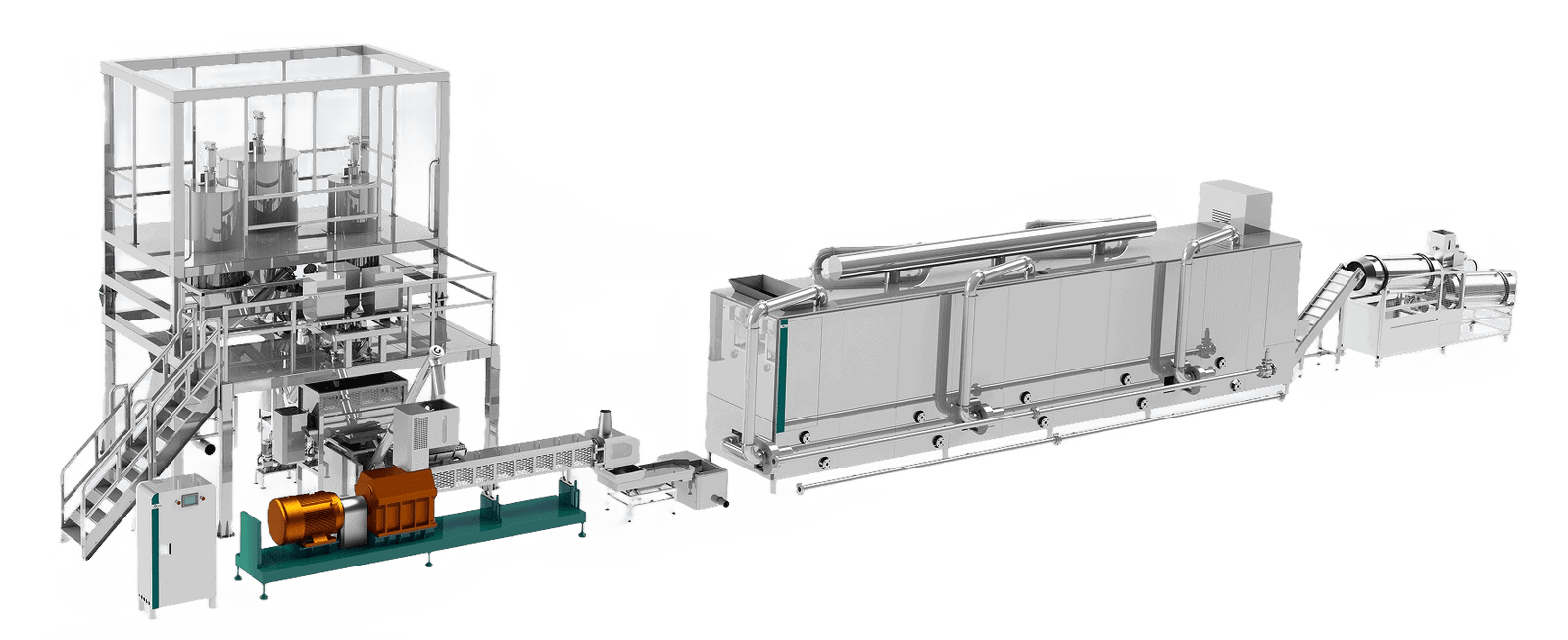
In the rapidly growing pet food industry, manufacturers often face the challenge of selecting the right machinery to produce high-quality dog food efficiently. Choosing the wrong type of machine can lead to inconsistent product quality, increased maintenance costs, and lower productivity. However, by understanding the various types of dog food machines available and their specific applications, manufacturers can optimize production, ensure product consistency, and meet market demand effectively.
There are several main types of dog food machines, including dry dog food extruders, wet dog food processing machines, vacuum coating machines, drying machines, and packaging machines. Each machine type serves a unique purpose in the production process, from shaping kibble to preserving freshness and ensuring hygienic packaging.
Understanding the functions and advantages of each dog food machine type is essential for anyone in the pet food manufacturing industry. Keep reading to learn which machines best suit your production goals and how they contribute to the overall efficiency and quality of your dog food production line.
What Is a Dry Dog Food Extruder Machine and How Does It Work?

In the pet food manufacturing industry, producing consistent, high-quality dry dog food at scale presents numerous challenges. Traditional production methods often fail to achieve the desired nutritional composition, shape uniformity, and shelf stability required by modern consumers. Additionally, inefficient machinery can drive up production costs and result in frequent downtimes. However, the solution to all these problems lies in one powerful piece of equipment: the dry dog food extruder machine. In this article, we will dive deep into what exactly a dry dog food extruder machine is, how it works, and why it is indispensable for modern dog food production.
A dry dog food extruder machine is a specialized piece of industrial equipment designed to process and shape various ingredients into dry dog kibble through a high-temperature, high-pressure extrusion process. It works by mixing raw materials, pushing them through a rotating screw inside a heated barrel, cooking the mixture, and forcing it through a die to create uniform kibble shapes. The extrusion process gelatinizes starches, denatures proteins, and ensures that the dog food is both digestible and shelf-stable.
If you’re looking to optimize your dog food production, understanding how an extruder machine functions is essential. Let’s explore the internal mechanics, benefits, and practical operation insights that will help you make the most informed decisions for your manufacturing setup.
Dry dog food extruder machines can only produce one type of kibble shape.False
Extruder machines can be customized with different dies to produce a variety of kibble shapes and sizes.
What Is a Dry Dog Food Extruder Machine?
A dry dog food extruder machine is a continuous processing device commonly used in large-scale pet food production facilities. It automates the blending, cooking, shaping, and partial drying of dog food ingredients. The key components typically include:
| Component | Function |
|---|---|
| Feed Hopper | Receives and stores the mixed raw ingredients before processing. |
| Screw Conveyor | Moves and compresses the mixture along the barrel. |
| Heated Barrel | Applies high temperatures and pressures to cook the ingredients. |
| Die Plate | Shapes the cooked mixture into uniform kibble pieces. |
| Cutting Knife | Cuts the extruded kibble to the desired length as it exits the die. |
| Control Panel | Allows operators to adjust parameters like temperature, pressure, and feed rate. |
How Does a Dry Dog Food Extruder Machine Work?
The extrusion process is a combination of mechanical, thermal, and chemical transformations. Here’s an in-depth breakdown of how it works:
1. Raw Material Feeding and Mixing
Ingredients such as meat meal, grains, vitamins, minerals, fats, and fibers are first mixed in precise proportions. These raw materials are pre-ground to a specific particle size to ensure consistency. The feed hopper introduces the mixture into the extruder at a controlled rate.
2. Conveyance and Compression
The rotating screw inside the barrel moves the raw mixture forward while simultaneously compressing it. The geometry of the screw (including its pitch, length-to-diameter ratio, and compression zones) is engineered to regulate shear forces and moisture levels.
3. Heating and Cooking
Inside the barrel, a combination of mechanical shear, friction, and external heating raises the temperature to around 90°C to 180°C (194°F to 356°F). The pressure can reach up to 30 bar. This thermal process denatures proteins, gelatinizes starches, and sterilizes the mixture, ensuring food safety and digestibility.
| Parameter | Typical Range | Function |
|---|---|---|
| Barrel Temperature | 90°C - 180°C | Cooks ingredients, ensuring starch gelatinization and protein denaturation. |
| Pressure | 15 - 30 bar | Controls moisture evaporation and kibble expansion. |
| Screw Speed | 200 - 500 RPM | Adjusts material throughput and shear force. |
| Moisture Content (Input) | 20% - 30% | Essential for proper extrusion and expansion. |
4. Die Shaping and Cutting
Once cooked, the pressurized mixture is forced through a die with holes matching the desired kibble shape (round, bone-shaped, star-shaped, etc.). Immediately afterward, a rotating knife cuts the extruded dog food into consistent lengths.
5. Drying and Cooling
The hot, moist kibble exits the extruder at approximately 20%-25% moisture content. A post-extrusion drying system reduces the moisture to 8%-12%, which is critical for shelf stability. Cooling fans or conveyors further stabilize the product before packaging.
Key Advantages of Dry Dog Food Extruder Machines
- Ingredient Versatility: Capable of processing a wide range of protein sources, grains, and additives.
- Consistent Kibble Quality: Uniform size, shape, and nutritional composition.
- Improved Digestibility: Thermal and mechanical treatments break down anti-nutritional factors.
- High Throughput: Continuous production suitable for large-scale operations.
- Cost-Efficiency: Reduces labor, waste, and downtime with automation and precise control.
Case Study: Optimizing Dog Food Production with Twin-Screw Extruders
One leading pet food manufacturer switched from single-screw to twin-screw extruders to handle higher volumes and diversified product lines. The result was:
| Performance Metric | Before (Single-Screw) | After (Twin-Screw) |
|---|---|---|
| Throughput Rate | 1,500 kg/hour | 3,000 kg/hour |
| Kibble Shape Variability | Limited (3 types) | Expanded (8 types) |
| Energy Consumption per kg | 0.65 kWh | 0.45 kWh |
| Product Recall Incidents | 2 per year | 0 per year |
This case illustrates the profound impact of selecting the right extruder technology on productivity and product differentiation.
Technical Maintenance and Best Practices
Proper maintenance is crucial to ensuring long-term machine efficiency. Key best practices include:
- Regularly inspecting and replacing worn screw and die components.
- Cleaning the barrel and screw after each production batch to avoid contamination.
- Monitoring temperature and pressure sensors for accuracy.
- Lubricating mechanical parts as per the manufacturer’s schedule.
Neglecting these maintenance practices can lead to inconsistent kibble quality, unexpected downtime, and higher operational costs.
Summary
In summary, a dry dog food extruder machine is an indispensable tool for modern pet food production, ensuring consistent, nutritious, and high-quality kibble. It uses a combination of mechanical force, heat, and precision engineering to transform raw ingredients into digestible, shelf-stable products efficiently.
Ready to Take Your Dog Food Production to the Next Level?
If you're looking to invest in or upgrade your dry dog food extrusion machinery, we offer customized solutions tailored to your capacity, product variety, and efficiency needs. Contact us today to get professional advice, technical support, and a competitive quote!
What Is a Wet Dog Food Processing Machine and What Are Its Features?
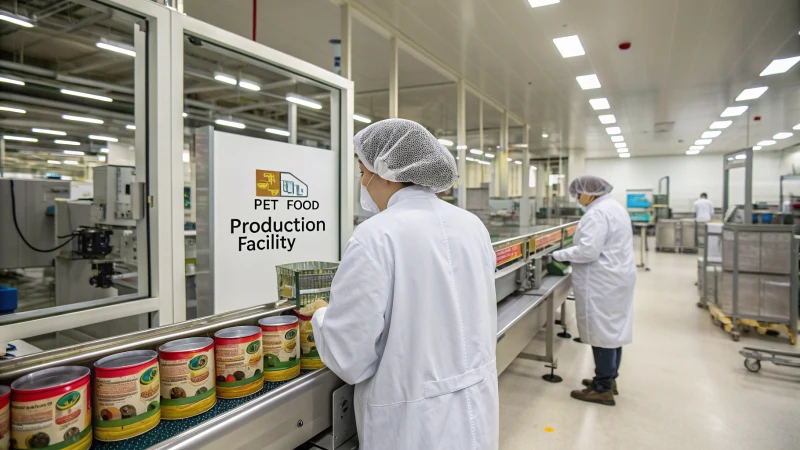
Manufacturers of wet dog food often face challenges such as maintaining product consistency, ensuring food safety, optimizing efficiency, and complying with stringent hygiene regulations. Traditional, manual processing methods can lead to contamination risks, product inconsistency, and production bottlenecks. This is where a wet dog food processing machine becomes essential. It automates and streamlines the entire production process, from raw material preparation to packaging, ensuring that the final product meets quality and safety standards. In this comprehensive article, we will explain what exactly a wet dog food processing machine is, how it works, and what features make it vital in modern pet food production facilities.
A wet dog food processing machine is an industrial system designed to automate the preparation, cooking, mixing, filling, and packaging of moist dog food products. These machines ensure hygienic, consistent, and efficient production, typically including components such as mixers, cookers, emulsifiers, filling systems, and sterilization units. Their key features include precise ingredient dosing, temperature control, hygienic design (usually stainless steel), CIP (Clean-in-Place) cleaning systems, and high production throughput.
Understanding how these machines function and their core features can help dog food manufacturers improve production efficiency, reduce contamination risk, and deliver premium wet dog food to the market. Keep reading to uncover essential insights!
Wet dog food processing machines only consist of mixers and cookers.False
Wet dog food processing machines are complete systems that include mixers, cookers, filling machines, sealing units, and sterilization systems to ensure a fully automated process.
What Is a Wet Dog Food Processing Machine?
A wet dog food processing machine refers to a complete, integrated line of industrial equipment that automates the production of wet or canned dog food. Unlike dry food extrusion systems, these machines handle high-moisture formulations, often above 70% water content, producing pâté, chunks in gravy, loaf-style, or stew-type dog foods.
Typical System Components:
| Component | Function |
|---|---|
| Ingredient Mixer | Blends meats, grains, vitamins, and other ingredients uniformly. |
| Emulsifier/Grinder | Breaks down meat and other components into fine, homogeneous paste. |
| Cooker (Batch or Continuous) | Cooks the mixture under precise temperature and pressure to sterilize and gel proteins. |
| Vacuum Deaerator | Removes air bubbles to prevent oxidation and spoilage. |
| Filling Machine | Accurately doses the wet mixture into cans, pouches, or trays. |
| Sealing Unit | Seals the filled containers hermetically to prevent contamination. |
| Retort Sterilizer | Applies high-pressure heat treatment to extend shelf life (often up to 2 years). |
| CIP (Clean-In-Place) System | Ensures thorough cleaning and sanitation of all contact surfaces without disassembling equipment. |
Features of Wet Dog Food Processing Machines
Here’s a detailed breakdown of the primary features that make these machines indispensable:
1. Precision Ingredient Dosing
Wet dog food recipes require exact proportions of meat, vegetables, grains, and supplements. The processing machine incorporates automated weighing systems, ensuring every batch meets nutritional specifications consistently. Some systems even include real-time recipe adjustment capabilities based on ingredient quality analysis.
2. High-Level Hygiene and Food Safety
To comply with pet food safety regulations (such as FDA and FSSC 22000), machines are manufactured with:
- Food-grade stainless steel (typically SUS304 or SUS316).
- Smooth, crevice-free surfaces to prevent bacterial buildup.
- CIP cleaning systems that minimize downtime and human error in sanitation.
- Vacuum deaerators that improve shelf stability and prevent microbial growth.
3. Efficient Cooking and Sterilization
Cooking is critical to kill pathogens and ensure product digestibility. The cooker (either batch-type or continuous) allows precise control of:
| Parameter | Typical Range | Purpose |
|---|---|---|
| Cooking Temperature | 80°C - 120°C (176°F - 248°F) | Gelatinizes starch, denatures proteins, kills harmful microorganisms. |
| Cooking Pressure | Up to 2 bar | Facilitates faster heat penetration and uniform cooking. |
| Cooking Time | 10 - 40 minutes | Adjustable based on product type and viscosity. |
Additionally, retort sterilizers process sealed containers at high temperatures (up to 130°C/266°F) under pressure to ensure long shelf life without preservatives.
4. Flexible Packaging Options
The filling systems are adaptable to various packaging formats:
| Packaging Format | Filling Speed Range | Container Sizes Supported |
|---|---|---|
| Cans | Up to 600 cans/min | 100g - 1000g |
| Pouches | Up to 500 pouches/min | 85g - 500g |
| Trays | Up to 400 trays/min | 200g - 1200g |
These machines can seamlessly switch between formats with minimal changeover time.
5. Automation and Control Systems
Advanced PLC (Programmable Logic Controller) systems are integrated into the machine for:
- Recipe management.
- Real-time monitoring of temperatures, pressures, and ingredient flow rates.
- Remote diagnostics and maintenance alerts.
- Batch traceability and quality control logging for audits.
Key Advantages of Wet Dog Food Processing Machines
- Increased Production Efficiency: Capable of continuous, high-volume output with reduced manual intervention.
- Consistent Product Quality: Eliminates human error in ingredient dosing and cooking, ensuring each batch is identical.
- Enhanced Shelf Life: Retort sterilization and vacuum deaeration extend product lifespan without compromising taste.
- Compliance with Safety Standards: Designed to meet global food safety requirements.
- Reduced Operational Costs: Energy-efficient designs, automated cleaning, and minimal waste contribute to lower production costs.
Real-World Example: Implementation Success
One major pet food producer integrated a fully automated wet dog food processing line, resulting in:
| Metric | Before Integration | After Integration |
|---|---|---|
| Daily Production Capacity | 25,000 cans/day | 75,000 cans/day |
| Batch-to-Batch Consistency | ±5% variance | ±1% variance |
| Cleaning Time per Shift | 3 hours | 45 minutes |
| Product Recall Incidents | 1/year | 0 incidents |
| Labor Requirement | 15 operators | 6 operators |
These improvements showcase the tangible benefits of deploying a modern wet dog food processing machine.
Technical Maintenance Tips
To maintain peak performance:
- Regularly inspect seals, filling nozzles, and heating elements.
- Perform CIP cycles daily.
- Lubricate moving parts following manufacturer schedules.
- Calibrate weighing and control systems periodically.
- Conduct microbial swab tests to ensure sanitary conditions.
Neglecting these tasks may result in contamination risks, costly downtime, and substandard product quality.
Conclusion
A wet dog food processing machine is an essential investment for any pet food manufacturer aiming for high efficiency, safety, and product consistency. Its integrated features—from precise ingredient mixing to advanced sterilization and flexible packaging—ensure manufacturers can meet market demands while maintaining top-tier quality standards.
Ready to Upgrade Your Wet Dog Food Production Line?
If you are considering enhancing or setting up a new wet dog food processing line, contact us today for tailored solutions, expert guidance, and competitive pricing. Let us help you achieve optimal production efficiency and quality!
How Does a Vacuum Coating Machine Enhance Dog Food Quality?

In the competitive pet food market, manufacturers strive to deliver dog food that not only meets nutritional standards but also appeals to pet owners in terms of quality, palatability, and appearance. Traditional surface application methods often fall short when it comes to ensuring uniform coating, precise nutrient delivery, and long-lasting freshness. Without advanced technology, crucial elements like fats, vitamins, and flavor enhancers can degrade quickly or fail to bind effectively to the kibble. Enter the vacuum coating machine, a game-changing innovation that addresses these issues. In this article, we’ll explain how a vacuum coating machine works and precisely how it enhances dog food quality.
A vacuum coating machine improves dog food quality by applying oils, vitamins, minerals, and flavor enhancers uniformly and deeply into the kibble under vacuum pressure. This method increases nutrient retention, enhances palatability, reduces surface oiliness, and improves shelf life by preventing oxidation. The vacuum process ensures even distribution and better absorption, making the product more appealing and nutritionally superior.
Curious to know exactly how this technology benefits your dog food production process? Keep reading to uncover the technical details and real-world advantages of vacuum coating technology.
Vacuum coating only applies oils to the surface of dog kibble.False
Vacuum coating allows oils, vitamins, and flavor enhancers to penetrate deeply into the kibble, not just the surface, ensuring uniform distribution and better nutrient stability.
What Is a Vacuum Coating Machine?
A vacuum coating machine is a specialized piece of equipment designed to apply liquid and powder additives, such as fats, oils, vitamins, and palatability enhancers, onto extruded or baked dog kibble. It operates under vacuum conditions, which allow the coating materials to be absorbed into the porous structure of the kibble instead of remaining on the surface.
Key Components of a Vacuum Coating Machine:
| Component | Function |
|---|---|
| Rotating Drum or Vessel | Contains the kibble and rotates to ensure even mixing and coating. |
| Vacuum Pump | Creates negative pressure (typically -0.8 to -0.95 bar) to evacuate air. |
| Liquid/Powder Injection Nozzles | Disperse oils, vitamins, and flavors uniformly over kibble. |
| Control Panel | Manages vacuum level, drum speed, and dosing parameters. |
| CIP (Clean-In-Place) System | Ensures hygienic cleaning without dismantling the machine. |
How Does Vacuum Coating Work?
The process can be broken down into detailed steps:
1. Kibble Loading
Finished kibble is loaded into the rotating drum or vessel. The kibble must be cooled and dried beforehand to avoid condensation inside the vacuum chamber.
2. Vacuum Creation
A powerful vacuum pump removes air from the chamber, creating a negative pressure environment (commonly between -0.8 and -0.95 bar). This vacuum opens up micro-pores in the kibble structure.
3. Additive Injection
Pre-measured amounts of oils, fats, vitamins, minerals, and flavor enhancers are sprayed or dripped onto the kibble via specialized nozzles. The vacuum environment allows these liquids to penetrate deeply and evenly.
4. Vacuum Release
Once the liquid additives are absorbed, the vacuum is slowly released. This pressure change causes any remaining surface oils to be drawn into the kibble pores, minimizing external residue.
5. Mixing and Discharging
The drum rotates at controlled speeds to ensure even distribution. The coated kibble is then discharged, cooled if necessary, and packaged.
| Parameter | Typical Range | Purpose |
|---|---|---|
| Vacuum Pressure | -0.8 to -0.95 bar | Enhances deep penetration of liquids into kibble. |
| Drum Rotation Speed | 5 - 20 RPM | Ensures uniform coating without damaging kibble. |
| Liquid Dosing Accuracy | ±0.5% | Provides precise nutrient application. |
| Coating Temperature | 20°C - 40°C (68°F - 104°F) | Maintains ingredient integrity, prevents nutrient degradation. |
Benefits of Vacuum Coating for Dog Food Quality
Here’s an in-depth look at how vacuum coating improves dog food:
1. Enhanced Nutrient Retention
Nutrients such as omega-3 fatty acids, vitamins A, D, E, and essential amino acids are sensitive to oxidation and heat. By applying them post-extrusion and under vacuum, degradation is minimized. The deep infusion ensures the nutrients are locked inside the kibble, maintaining their potency until consumption.
| Nutrient | Traditional Surface Application | Vacuum Coating Application |
|---|---|---|
| Vitamin E Retention (%) | 70% | 95% |
| Omega-3 Stability | Prone to oxidation | Protected, extended shelf life |
| Palatant Distribution | Uneven | Uniform, consistent taste |
2. Improved Palatability
Flavor enhancers and palatants are evenly distributed and absorbed deeply into the kibble, ensuring a consistent taste and smell profile. This makes the food more attractive to dogs, particularly picky eaters.
3. Reduced Surface Oiliness
Unlike conventional coating methods, vacuum coating prevents oils from remaining on the surface, which:
- Reduces the greasy feel.
- Prevents clumping during packaging.
- Minimizes rancidity and oxidation risks.
4. Extended Shelf Life
Since oils and sensitive nutrients are infused within the kibble and protected from air exposure, shelf life can be extended by 6 to 12 months compared to surface-coated products.
5. Precise Dosing Control
The machine’s control system allows for exact dosing of functional additives like joint supplements (glucosamine), probiotics, or specific fat blends. This precision ensures nutritional compliance and formulation consistency.
Case Study: Production Improvement with Vacuum Coating
A leading premium pet food manufacturer adopted vacuum coating technology and recorded the following improvements:
| Performance Metric | Before (Surface Coating) | After (Vacuum Coating) |
|---|---|---|
| Vitamin A Retention (%) | 75% | 96% |
| Shelf Life | 12 months | 18 months |
| Palatability Test Acceptance | 82% | 98% |
| Production Waste (Clumped Kibble) | 3% | <0.5% |
| Customer Complaints on Oiliness | Frequent | Negligible |
This clearly demonstrates how vacuum coating translates to superior product quality, customer satisfaction, and profitability.
Maintenance and Best Practices
For optimal performance, operators should:
- Regularly inspect seals and vacuum pumps.
- Calibrate dosing systems weekly.
- Perform CIP cycles after each production shift.
- Monitor nutrient retention data to adjust parameters accordingly.
Neglecting these steps could compromise product quality and increase downtime.
Conclusion
A vacuum coating machine is a crucial asset in enhancing dog food quality. It offers unmatched advantages in nutrient retention, palatability, shelf life, and precision dosing. By integrating this technology, manufacturers can produce superior dog food that meets consumer demands for premium, nutritious, and safe pet products.
Looking to Elevate Your Dog Food Production Quality?
If you want to incorporate vacuum coating technology into your production line or need expert consultation, contact us today. Our specialists can help design the ideal solution tailored to your product goals and production capacity.
What Role Do Drying Machines Play in Dog Food Production?
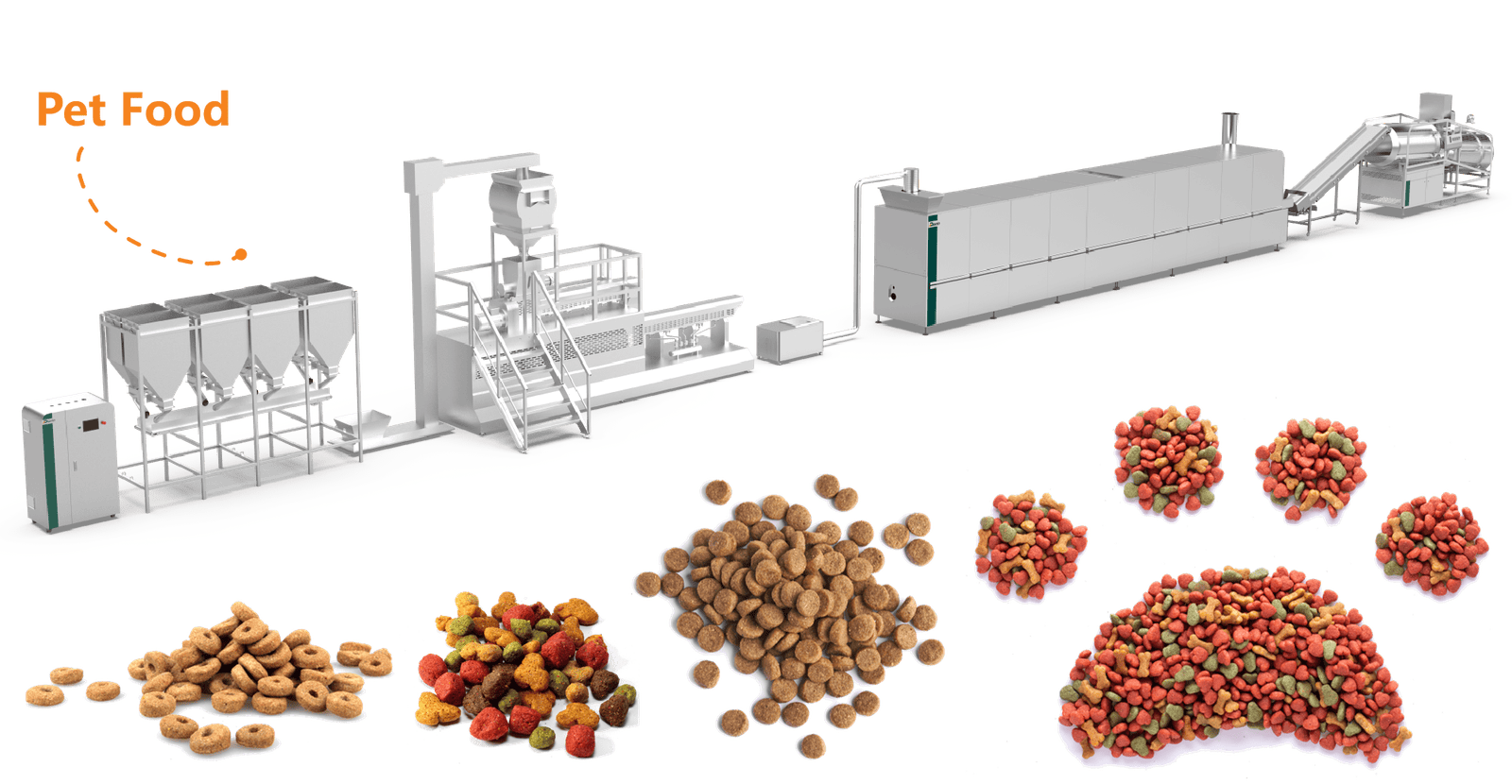
Inconsistent moisture content, microbial contamination, and short shelf life are some of the most common and costly issues in dog food manufacturing. Without proper moisture control, dog food becomes prone to spoilage, mold growth, and nutrient degradation, leading to product recalls, financial losses, and damage to brand reputation. This is precisely where drying machines play a vital role. They are the cornerstone of ensuring product stability, safety, and quality. In this in-depth article, we will explore the critical role drying machines serve in dog food production, how they work, and why they are indispensable to the pet food industry.
Drying machines in dog food production are used to reduce the moisture content of extruded or baked dog food to optimal levels (typically 8%-12%) to ensure shelf stability, prevent microbial growth, and preserve nutritional quality. They achieve this by applying controlled heat and airflow, allowing uniform and consistent drying across all kibble or product types.
If you want to fully understand how drying machines directly impact dog food quality and shelf life, continue reading for detailed technical insights and operational best practices.
Dog food drying machines are optional in modern dog food production.False
Drying machines are essential in dog food production to control moisture content, prevent spoilage, and ensure product safety and stability.
What Is a Dog Food Drying Machine?
A dog food drying machine, also known as a pet food dryer, is an industrial system designed to remove excess moisture from the kibble or wet-processed dog food after extrusion, baking, or vacuum coating. The drying process stabilizes the product, enhances its texture, and extends its shelf life.
Common Types of Drying Machines:
| Dryer Type | Description | Application |
|---|---|---|
| Conveyor Dryer | Continuous drying using multi-tier belts and forced airflow. | Large-scale dry kibble production. |
| Fluidized Bed Dryer | Uses upward airflow to suspend and dry individual kibble pieces evenly. | Small to medium production lines, uniform products. |
| Batch Tray Dryer | Static trays with circulating hot air. | Specialty dog food batches or experimental lines. |
| Rotary Drum Dryer | Rotating drum with heated airflow, providing tumbling action for even drying. | Chunk or moist dog food drying. |
How Do Drying Machines Work?
Let’s break down the process step by step:
1. Product Feeding
Post-extrusion or post-baking, dog food with high moisture content (typically 20%-25%) is fed into the dryer either via conveyors or manually placed on trays, depending on the machine type.
2. Controlled Heating and Airflow
The drying chamber applies controlled heat, generally between 80°C to 130°C (176°F to 266°F). Simultaneously, powerful fans circulate hot air uniformly across all product layers. Temperature zones may vary throughout the dryer to ensure gradual, even moisture reduction.
3. Moisture Evaporation
Heat causes water within the dog food to evaporate. Humidity sensors and exhaust systems control and remove moist air efficiently. The goal is to lower moisture content to 8%-12%, the ideal range to prevent mold growth and spoilage.
4. Cooling (Optional)
Some drying systems integrate a cooling section at the end to bring kibble to ambient temperature, preventing condensation during packaging.
| Parameter | Typical Range | Purpose |
|---|---|---|
| Inlet Temperature | 100°C - 130°C | Initial moisture removal. |
| Outlet Temperature | 50°C - 80°C | Final drying and prevention of nutrient degradation. |
| Residence Time | 20 - 40 minutes | Time required for thorough drying. |
| Air Velocity | 2 - 5 m/s | Ensures uniform airflow and drying efficiency. |
| Final Moisture Content | 8% - 12% | Prevents spoilage and microbial growth. |
Why Are Drying Machines Essential in Dog Food Production?
1. Moisture Control Ensures Shelf Stability
Excess moisture creates the perfect environment for mold, yeast, and bacterial growth. By reducing moisture to the safe threshold, drying machines extend the product’s shelf life from a few weeks to 12-24 months without requiring artificial preservatives.
| Moisture Content (%) | Microbial Growth Risk | Shelf Life |
|---|---|---|
| Above 14% | High | Less than 2 months |
| 8% - 12% | Low | 12-24 months |
2. Preservation of Nutritional Quality
Rapid and controlled drying minimizes nutrient loss, particularly of heat-sensitive ingredients like:
- Vitamins (A, E, D).
- Amino acids.
- Fatty acids (Omega-3 and Omega-6).
Advanced drying machines use multi-zone temperature control to balance effective drying with nutrient preservation.
3. Uniform Texture and Appearance
Dryers prevent over-drying or under-drying, ensuring uniform kibble hardness and avoiding burnt or brittle products. This consistency improves packaging flowability and enhances consumer acceptance.
4. Energy Efficiency and Cost Control
Modern dryers incorporate energy recovery systems and real-time monitoring to minimize energy consumption, reducing operational costs while maintaining drying efficiency.
Case Study: Drying Machine Impact on Production Efficiency
One leading dog food manufacturer upgraded to a multi-tier conveyor dryer and recorded the following results:
| Metric | Before (Basic Tray Dryer) | After (Conveyor Dryer) |
|---|---|---|
| Batch Drying Time | 2.5 hours | 40 minutes |
| Energy Consumption per kg | 0.85 kWh | 0.45 kWh |
| Product Waste (Over/Under Dry) | 7% | <1% |
| Shelf Life | 10 months | 18 months |
| Final Moisture Variance | ±4% | ±1% |
This demonstrates how investing in advanced drying machinery leads to higher efficiency, quality control, and profitability.
Maintenance and Operational Best Practices
Proper maintenance ensures consistent machine performance:
- Daily cleaning of airflow ducts and conveyor belts.
- Inspection of heating elements, sensors, and seals weekly.
- Lubrication of moving parts following manufacturer schedules.
- Calibration of temperature and humidity sensors monthly.
- Regular microbial testing of the drying chamber.
Neglecting these tasks may result in uneven drying, increased energy costs, and contamination risks.
Conclusion
In summary, drying machines are the backbone of dog food production, ensuring optimal moisture control, extended shelf life, consistent texture, and nutrient preservation. Without them, manufacturers face significant risks of spoilage, safety violations, and product inconsistency.
Ready to Optimize Your Dog Food Drying Process?
Looking to enhance the efficiency, quality, and profitability of your dog food production? Contact us today for expert guidance and customized drying machine solutions tailored to your production needs.
What Are the Key Functions of Dog Food Packaging Machines?
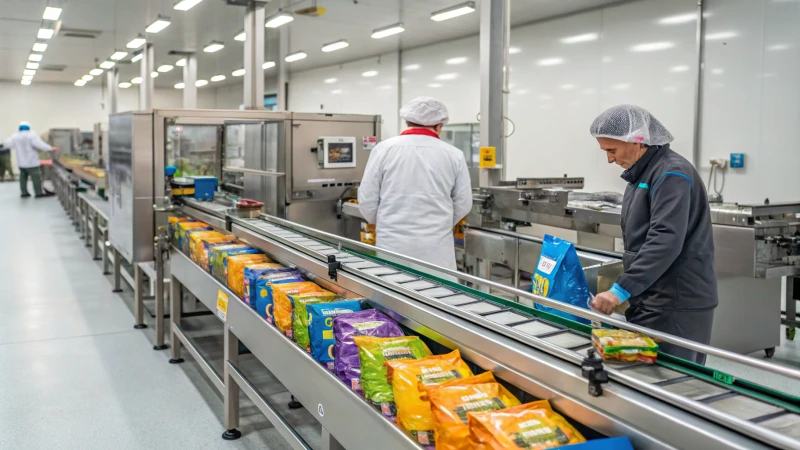
In the dog food manufacturing industry, even the highest quality product can fail in the market without effective packaging. Poor packaging can lead to spoilage, contamination, product damage, or consumer dissatisfaction. Manual packaging processes are labor-intensive, prone to errors, and lack consistency. This is where dog food packaging machines play a vital role, providing automated, hygienic, and efficient solutions for packaging various types of dog food products. In this article, we will explore the key functions of dog food packaging machines and explain how they contribute to product safety, shelf appeal, and operational efficiency.
Dog food packaging machines perform essential functions such as precise weighing and filling of dog food, sealing bags or containers securely, labeling and coding for traceability, ensuring product freshness, and enhancing packaging speed and consistency. These machines can handle various packaging formats, including bags, pouches, cans, and trays, while complying with hygiene and safety standards.
Want to understand how these machines optimize your production line? Keep reading to explore their core functionalities in detail!
Dog food packaging machines are only used for sealing bags.False
Dog food packaging machines handle multiple tasks including filling, weighing, sealing, labeling, coding, and quality checks to ensure complete packaging automation.
What Is a Dog Food Packaging Machine?
A dog food packaging machine is an automated system designed to package dry or wet dog food into various container types while maintaining product integrity and efficiency. They are tailored to meet the specific requirements of pet food products, ensuring compliance with hygiene regulations and customer preferences.
Common Packaging Formats Handled:
| Packaging Format | Typical Sizes Supported | Application |
|---|---|---|
| Bags (Pillow, Gusseted, Quad-seal) | 500g - 20kg | Dry dog kibble bulk packaging |
| Stand-up Pouches | 100g - 2kg | Premium dry or moist dog food |
| Cans | 85g - 1kg | Wet dog food, pâté, chunks in gravy |
| Trays | 200g - 1.2kg | Ready-to-eat meals or specialty products |
Key Functions of Dog Food Packaging Machines
Let’s dive into the core functions of these machines:
1. Weighing and Dosing Precision
Accurate portioning is crucial for both customer satisfaction and regulatory compliance. Packaging machines integrate multi-head weighers or auger fillers depending on product type:
| Weighing System | Best For | Accuracy Range |
|---|---|---|
| Multi-Head Weighers | Dry kibble, granules | ±0.5% |
| Auger Fillers | Powdered supplements, meal mix | ±1% |
| Volumetric Fillers | Wet food chunks in gravy | ±1% to ±2% |
These systems ensure each package contains the exact specified amount, reducing product giveaway and improving consistency.
2. Bag/Pouch/Forming and Filling
The packaging machine forms bags or uses pre-made pouches, filling them with the precisely weighed product. Advanced machines can switch between different packaging formats with minimal downtime, offering flexibility in production lines.
| Parameter | Typical Range | Purpose |
|---|---|---|
| Bag Width Range | 80mm - 500mm | Supports various bag sizes. |
| Filling Speed | Up to 80 bags/min (dry food) | Increases production efficiency. |
| Product Type Adaptability | Dry kibble, moist chunks, powders | Handles diverse dog food products. |
3. Sealing for Product Freshness
The sealing function is critical for preserving freshness and preventing contamination. Depending on the packaging material, machines may utilize:
- Heat sealing (for plastic bags, pouches).
- Vacuum sealing (for extended shelf life).
- Metal can sealing (for wet dog food cans).
Consistent sealing prevents oxygen ingress, maintaining flavor, aroma, and preventing spoilage.
4. Labeling and Coding
Packaging machines can be integrated with:
- Label applicators (for product branding and information).
- Inkjet or laser coders (for batch numbers, expiration dates, traceability codes).
Accurate labeling is essential for legal compliance, customer information, and supply chain traceability.
5. Quality Inspection Systems
Advanced systems incorporate:
| Inspection Feature | Function |
|---|---|
| Metal Detectors | Detect foreign metal contaminants. |
| Checkweighers | Verify final package weight to ensure accuracy. |
| Vision Systems | Inspect labels, barcodes, and seal integrity. |
These systems reduce the risk of defective products reaching consumers, preventing recalls and maintaining brand reputation.
6. Product Counting and Grouping
Machines can also automatically:
- Count packaged units.
- Group products for secondary packaging (such as cartons or pallets).
- Integrate seamlessly with end-of-line automation (e.g., case packers, palletizers).
7. Hygienic and Sanitary Design
Dog food packaging machines are designed for:
- Stainless steel construction (SUS304/SUS316) for easy cleaning.
- Smooth, crevice-free surfaces to prevent bacterial buildup.
- Compliance with hygiene standards (FDA, FSSC 22000).
- Clean-In-Place (CIP) systems for thorough sanitation.
This minimizes contamination risks and ensures product safety.
Real-World Example: Efficiency Gains from Packaging Machine Integration
One leading dog food producer integrated a fully automated packaging machine and achieved:
| Performance Metric | Before (Manual Packaging) | After (Automated Packaging) |
|---|---|---|
| Packaging Speed | 12 bags/min | 70 bags/min |
| Weight Accuracy Variance | ±5% | ±0.5% |
| Product Waste | 4% | <1% |
| Labor Requirement | 15 operators | 4 operators |
| Shelf Life Complaints | Frequent | Negligible |
This illustrates how packaging machines directly improve production efficiency, product consistency, and customer satisfaction.
Maintenance and Best Practices
For optimal machine performance:
- Conduct daily cleaning and sanitation of all product-contact surfaces.
- Inspect sealing jaws, filling nozzles, and weighers weekly.
- Calibrate weighing and coding systems monthly.
- Lubricate mechanical components regularly.
- Perform periodic preventive maintenance as per manufacturer guidelines.
Neglecting these practices can result in downtime, packaging defects, and compliance violations.
Conclusion
Dog food packaging machines perform multiple key functions, including accurate weighing, filling, sealing, labeling, coding, and quality inspection. They play a crucial role in preserving product freshness, ensuring safety, maintaining brand consistency, and enhancing production efficiency.
Ready to Automate Your Dog Food Packaging Process?
If you are looking to optimize your dog food packaging line or need customized packaging solutions, contact us today. Our expert team can provide tailored machine configurations to meet your specific production requirements and help you achieve superior efficiency and quality!
How to Choose the Right Dog Food Machines for Your Production Line?
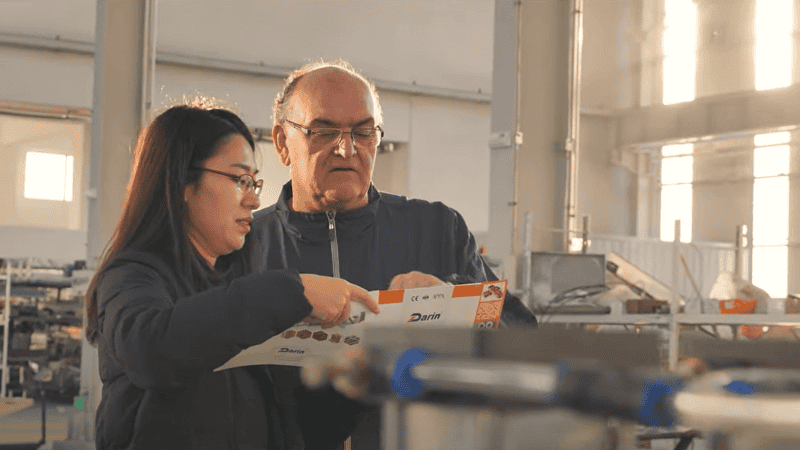
The pet food market is booming, but poor equipment choices can cause massive setbacks—ranging from inconsistent product quality, machine breakdowns, excessive energy consumption, to significant financial losses. Many manufacturers find themselves struggling to meet increasing demand, maintaining consistent kibble shapes, or keeping up with strict hygiene standards. Choosing the right dog food machines can not only eliminate these headaches but also boost efficiency, reduce production costs, and ensure product quality that keeps customers loyal. This guide will help you navigate the critical factors to select the best dog food processing machinery tailored to your production needs.
To choose the right dog food machines for your production line, you must assess key factors such as production capacity, machine compatibility, extrusion technology, energy efficiency, sanitation standards, automation level, and cost-effectiveness. Prioritize machines that offer flexibility for various dog food formulas, easy maintenance, and compliance with safety and hygiene regulations. Investing in reliable equipment ensures consistent quality, reduces downtime, and supports long-term profitability.
Selecting the right dog food machinery is crucial because the wrong choice could severely limit your production efficiency, increase operational costs, or fail to meet growing market demands. Keep reading to understand the technical nuances and key decision points that will ensure you choose the most reliable and suitable equipment for your facility.
Dog food extruders must operate at high temperatures to properly cook and shape kibble.True
High-temperature extrusion ensures proper cooking, shaping, and safety of dog food by killing harmful pathogens.
Understanding the Core Dog Food Machine Types
In a typical dog food production line, several critical machines are involved, each performing specialized functions. Let’s delve into each category:
| Machine Type | Function | Key Considerations |
|---|---|---|
| Raw Material Mixer | Uniformly blends raw ingredients before extrusion. | Volume capacity, mixing speed, material quality, cleaning ease. |
| Twin-Screw Extruder | Cooks, shapes, and expands the kibble. | Screw design, temperature control, torque, die variety, output capacity. |
| Dryer (Multi-layer) | Removes moisture for shelf stability. | Energy efficiency, temperature uniformity, adjustable drying time. |
| Coating Machine | Applies fats, flavors, and vitamins. | Spray evenness, liquid distribution control, hygienic design. |
| Cooling Conveyor | Cools down kibble to safe packaging temperature. | Conveyor speed, airflow, material (stainless steel preferred). |
| Packaging Machine | Packs the kibble into bags with correct weight and sealing. | Accuracy, speed, bag size flexibility, sealing efficiency. |
Key Factors to Consider
1. Production Capacity & Scalability
Your daily or hourly production targets will significantly dictate the specifications of the machines. For instance, smaller operations (1-2 tons/hour) might use compact extruders and mixers, while large-scale facilities (>10 tons/hour) will require high-torque twin-screw extruders, larger dryers, and advanced automated packaging systems.
| Production Scale | Recommended Extruder Capacity | Mixer Volume | Dryer Size |
|---|---|---|---|
| Small (1-2 tons/hour) | 50-100kg/h | 200-500L | 3-layer, moderate size |
| Medium (3-6 tons/hour) | 300-500kg/h | 1000L | 5-layer, large scale |
| Large (10+ tons/hour) | 800kg/h - 1ton/h | 2000L+ | 7-layer, industrial |
Ensure machines can be easily scaled or upgraded as your business grows.
2. Extrusion Technology: Single-Screw vs. Twin-Screw
| Parameter | Single-Screw Extruder | Twin-Screw Extruder |
|---|---|---|
| Flexibility | Less flexible, suitable for simple recipes | Highly flexible, supports varied formulas |
| Cost | Lower initial cost | Higher upfront cost but better returns |
| Product Quality | Basic, inconsistent shapes | Consistent kibble size & shape |
| Maintenance | Easier, fewer parts | Slightly complex, requires expertise |
For premium or varied dog food products, twin-screw extruders are preferred.
3. Material & Hygiene Standards
Machines made of food-grade stainless steel are essential for sanitary production and compliance with FDA or CE certifications. Features such as easy disassembly, CIP (clean-in-place) systems, and smooth internal surfaces help prevent bacterial buildup and contamination.
Stainless steel construction is mandatory for all dog food processing machinery.False
While stainless steel is highly recommended for hygiene, some smaller components may use food-safe plastics or alloys.
4. Automation & Control Systems
Modern dog food machinery integrates PLC (Programmable Logic Controller) systems, HMI (Human-Machine Interface), and IoT capabilities to monitor:
- Extrusion temperature
- Screw speed
- Moisture levels
- Coating liquid flow
- Packaging weight
Investing in automation minimizes human error, ensures consistent production, and enables real-time adjustments.
5. Energy Efficiency & Environmental Compliance
Energy-efficient motors, insulation, and heat recovery systems can significantly reduce operational costs. Additionally, machines should meet environmental standards regarding emissions, waste management, and energy consumption.
Case Study: Efficient Dog Food Line Setup
A pet food manufacturer in Germany faced increasing demand but struggled with inconsistent kibble quality. By upgrading from single-screw to twin-screw extruders and integrating an automated coating machine, they improved product uniformity, reduced waste by 12%, and increased production capacity from 3 to 6 tons/hour.
Critical Technical Checklist Before Purchasing
| Parameter | Ideal Specification |
|---|---|
| Material | 304/316 stainless steel |
| Extruder Screw Configuration | Twin-screw, modular design |
| Temperature Control | PID-controlled, ±1°C accuracy |
| Motor Type | Energy-saving, frequency-adjustable motors |
| Certifications | CE, ISO9001, FDA compliant |
| Cleaning System | CIP (Clean-In-Place) ready |
| Warranty & After-sales Support | Minimum 1-year warranty, 24/7 technical support available |
Conclusion
Choosing the right dog food machines is not merely a capital expenditure—it’s a strategic investment that determines your production efficiency, product quality, and long-term market success. Carefully analyzing capacity needs, machine compatibility, technical specifications, and hygiene compliance will ensure smooth operations and profitable returns.
Contact Us for Expert Assistance!
Need help configuring your dog food production line? Contact us today to get customized machinery solutions tailored specifically for your production goals. Our team of experts will guide you every step of the way. Let’s optimize your dog food production together!
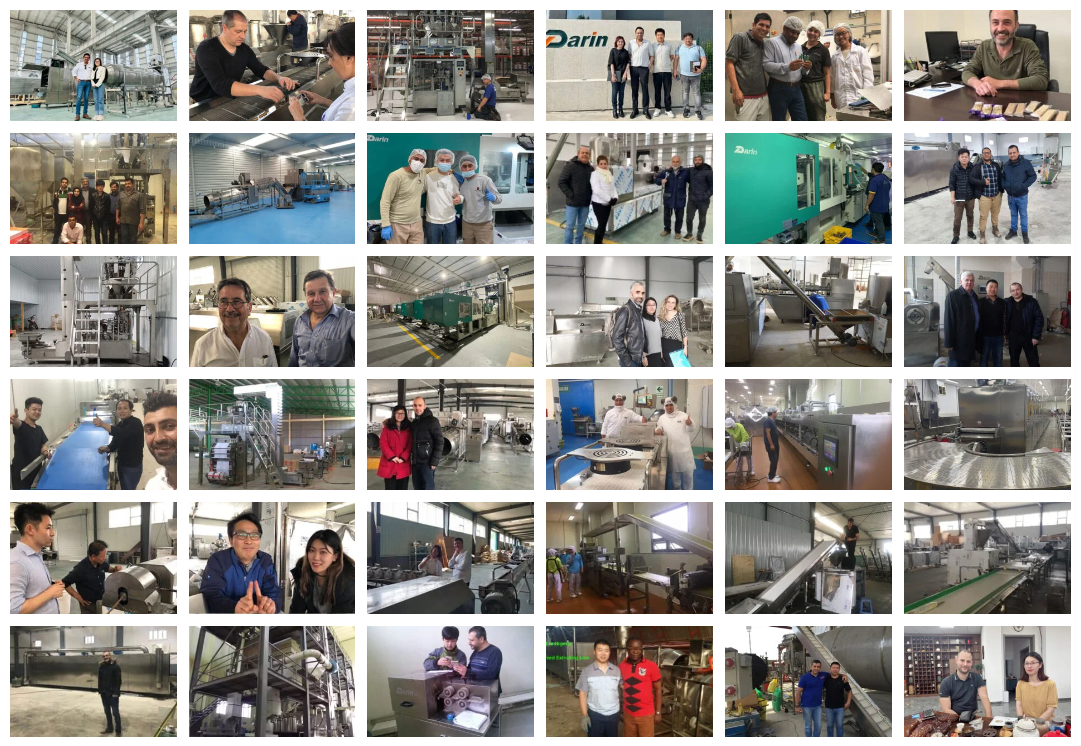
Conclusion
By understanding each type of dog food machine in detail, manufacturers can make informed decisions that streamline production and improve product quality, ensuring they remain competitive in the growing pet food market.
Ready to upgrade your dog food production line? Contact us today for expert guidance and high-performance dog food machinery solutions tailored to your needs!
References
- Pet Food Processing Equipment Overview - https://www.petfoodprocessing.net/articles/12072-overview-of-pet-food-processing-equipment - Pet Food Processing
- Dog Food Extruder Machine Guide - https://www.extrudermachine.com/dog-food-extruder - Extruder Machine Manufacturer
- How to Choose Dog Food Machines - https://www.petfoodindustry.com/articles/11299-how-to-choose-dog-food-machines - Pet Food Industry
- Dog Food Production Line Types - https://www.saintyco.com/dog-food-production-line - SaintyCo
- Dog Food Packaging Solutions - https://www.tna-solutions.com/packaging-solutions/dog-food - TNA Solutions
- Wet Pet Food Processing Basics - https://www.gea.com/en/products/pet-food-processing - GEA Group
- Pet Food Pellet Machine Details - https://www.gcmec.com/dog-food-pellet-machine - GCMEC
- Energy Efficient Dog Food Machines - https://www.petfoodprocessing.net/articles/12071-energy-efficient-pet-food-machinery - Pet Food Processing
- Maintenance Tips for Dog Food Equipment - https://www.petsource.com/articles/1018-maintenance-of-pet-food-machines - PetSource
- Modular Pet Food Machinery Systems - https://www.buhlergroup.com/global/en/products/pet-food-processing - Bühler Group


